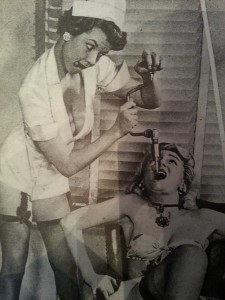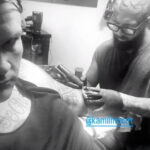So, you’ve just gotten some fresh ink, and you’re probably wondering, “Can you put lotion on a tattoo?” Absolutely, moisturizing is a crucial part of tattoo aftercare! Using the right lotion helps keep your skin hydrated, promoting faster healing and preventing your new tattoo from drying out and scabbing excessively. At tattooat.com, we provide all the resources needed from tattoo designs to artists, and aftercare advice. Keep reading to learn everything about tattoo healing, proper skincare, and maintaining vibrant body art.
1. Why Is Lotion Important for Tattoo Aftercare?
Applying lotion to a new tattoo is vital for several reasons, going beyond just basic skincare. The right moisturizer can significantly impact the healing process and the long-term appearance of your tattoo.
- Hydration: A new tattoo is essentially an open wound, and keeping it hydrated prevents the skin from drying out and cracking. Hydrated skin is more elastic and less prone to damage, aiding in quicker healing.
- Reduces Scabbing: Dry skin leads to excessive scabbing, which can pull out ink and cause uneven healing. Lotion keeps the area moist, minimizing scab formation and ensuring the ink settles properly.
- Prevents Itching: As a tattoo heals, it’s common to experience itching. Lotion can alleviate this discomfort by soothing the skin and reducing the urge to scratch, which can damage the tattoo.
- Enhances Color: Properly moisturized skin helps to maintain the vibrancy of the tattoo ink. Hydrated skin reflects light better, making the colors appear brighter and more defined.
Ultimately, using lotion is about promoting optimal healing and preserving the quality of your tattoo for years to come.
2. What Type of Lotion Is Best for New Tattoos?
Choosing the right lotion is crucial for effective tattoo aftercare. Not all lotions are created equal, and some can even hinder the healing process or cause irritation. Here’s what to look for:
- Fragrance-Free: Scented lotions often contain alcohol and synthetic fragrances that can irritate the sensitive skin around a new tattoo. These additives can cause redness, itching, and even allergic reactions.
- Uncolored: Dyes and artificial colors in lotions can also irritate a healing tattoo. Opt for a plain, white lotion to minimize the risk of adverse reactions.
- Hypoallergenic: This means the lotion is formulated to minimize the risk of allergic reactions. It’s especially important for those with sensitive skin or a history of skin conditions.
- Non-Comedogenic: This type of lotion won’t clog pores, which is essential to prevent breakouts around the tattoo area. Clogged pores can lead to inflammation and delay healing.
- Free of Harsh Chemicals: Avoid lotions with ingredients like parabens, sulfates, and alcohol, as these can dry out the skin and cause irritation.
- Specifically Designed for Tattoos: Some brands offer lotions specifically formulated for tattoo aftercare, containing ingredients that promote healing and protect the ink.
2.1 Recommended Lotions
Several lotions are widely recommended by tattoo artists and enthusiasts for their gentle and effective moisturizing properties.
| Lotion | Key Benefits |
|---|---|
| Aveeno Fragrance-Free Daily Moisturizing Lotion | Known for its soothing and moisturizing properties, Aveeno contains natural colloidal oatmeal, which helps to relieve itching and irritation. It’s gentle enough for sensitive skin and free of fragrances and dyes. |
| Curel Fragrance-Free Lotion | Curel provides long-lasting hydration and is specifically designed for dry and sensitive skin. It’s non-greasy and absorbs quickly, making it comfortable to wear throughout the day. |
| Eucerin Advanced Repair Lotion | Eucerin is a dermatologist-recommended brand known for its effective moisturizing capabilities. It contains ceramides and natural moisturizing factors that help to repair and protect the skin’s barrier, promoting faster healing. |
| Hustle Butter Deluxe | This is a popular choice among tattoo artists and enthusiasts. It’s made with shea, mango, and aloe butters, as well as coconut and sunflower oils. It’s designed to moisturize, soothe, and protect the tattoo while keeping the colors vibrant. |
| Tattoo Goo | Tattoo Goo is specifically formulated for tattoo aftercare. It contains natural ingredients like olive oil, cocoa butter, and beeswax, which help to moisturize and protect the tattoo. It’s also effective in reducing itching and promoting faster healing. |
| Sanibal Solution Tattoo Aftercare Lotion | Designed specifically for new tattoos, Sanibal Solution offers gentle yet effective hydration. Its formula helps to reduce inflammation and promote skin regeneration, ensuring optimal healing and vibrant color retention. |
2.2 Ingredients to Look For
When evaluating lotions, keep an eye out for these beneficial ingredients:
- Panthenol (Vitamin B5): Known for its moisturizing and healing properties, panthenol helps to soothe irritated skin and promote tissue repair.
- Glycerin: A humectant that attracts moisture to the skin, keeping it hydrated and supple.
- Shea Butter: A natural emollient that softens and moisturizes the skin, while also providing anti-inflammatory benefits.
- Vitamin E: An antioxidant that helps to protect the skin from damage and promote healing.
- Aloe Vera: Known for its soothing and anti-inflammatory properties, aloe vera can help to relieve itching and irritation.
- Jojoba Oil: Closely resembles the skin’s natural sebum, making it an excellent moisturizer that won’t clog pores.
2.3 Ingredients to Avoid
Certain ingredients can be harmful to a healing tattoo and should be avoided:
- Alcohol: Dries out the skin and can cause irritation.
- Petroleum-Based Products (e.g., Vaseline): Can trap moisture and bacteria, increasing the risk of infection.
- Lanolin: Can cause allergic reactions in some people.
- Mineral Oil: Can clog pores and prevent the skin from breathing.
 Freshly inked forearm tattoo with intricate geometric design and shading, highlighting the importance of aftercare and moisturizing for optimal healing
Freshly inked forearm tattoo with intricate geometric design and shading, highlighting the importance of aftercare and moisturizing for optimal healing
3. How to Properly Apply Lotion to Your Tattoo
Knowing how to apply lotion correctly is just as important as choosing the right product. Proper application ensures that your tattoo receives the maximum benefits without causing any harm.
- Wash Your Hands: Always start with clean hands to prevent introducing bacteria to the healing tattoo.
- Clean the Tattoo: Gently wash the tattoo with a mild, fragrance-free antibacterial soap and warm water. Use your fingertips to clean the area, avoiding harsh scrubbing.
- Pat Dry: Pat the tattoo dry with a clean, lint-free cloth or paper towel. Avoid rubbing, as this can irritate the skin.
- Wait a Few Minutes: Allow the tattoo to air dry for a few minutes before applying lotion. This helps to ensure that the skin is completely dry and ready to absorb the moisturizer.
- Apply a Thin Layer: Use a small amount of lotion and gently massage it into the tattoo area. The layer should be thin enough that it absorbs quickly and doesn’t leave a greasy residue.
- Don’t Over-Moisturize: Applying too much lotion can trap moisture and prevent the skin from breathing, which can lead to complications. Less is more when it comes to moisturizing a tattoo.
- Repeat as Needed: Apply lotion 3-5 times a day, or whenever the tattoo feels dry or tight. It’s important to keep the area consistently moisturized, but avoid overdoing it.
- Listen to Your Skin: Pay attention to how your skin responds to the lotion. If you notice any redness, itching, or irritation, discontinue use and consult with your tattoo artist or a dermatologist.
By following these steps, you can ensure that you’re moisturizing your tattoo effectively and promoting optimal healing.
4. Common Mistakes to Avoid When Moisturizing Your Tattoo
Even with the best intentions, it’s easy to make mistakes when caring for a new tattoo. Here are some common pitfalls to avoid:
- Using Scented or Colored Lotions: As mentioned earlier, these can cause irritation and allergic reactions.
- Applying Too Much Lotion: Over-moisturizing can lead to clogged pores and prevent the skin from breathing, which can hinder healing.
- Using Petroleum-Based Products: These can trap moisture and bacteria, increasing the risk of infection.
- Picking Scabs: This is a major no-no. Picking scabs can pull out ink and cause scarring, resulting in an uneven or faded tattoo.
- Scratching the Tattoo: Itching is a normal part of the healing process, but scratching can damage the skin and increase the risk of infection.
- Ignoring Signs of Infection: If you notice excessive redness, swelling, pus, or a foul odor, seek medical attention immediately.
- Sun Exposure: Direct sunlight can fade the ink and damage the healing skin. Always protect your tattoo with sunscreen or clothing when outdoors.
- Not Washing the Tattoo Regularly: Keeping the tattoo clean is essential to prevent infection. Wash it gently with a mild antibacterial soap at least once a day.
- Soaking the Tattoo: Avoid prolonged soaking in water, such as swimming or taking long baths, as this can interfere with the healing process.
5. The Tattoo Healing Process: What to Expect
Understanding the stages of tattoo healing can help you provide the best care and avoid unnecessary worry. The healing process typically takes 2-4 weeks, but can vary depending on the size, location, and your body’s natural healing ability.
- Week 1: Initial Healing
- The tattoo will be tender, red, and possibly slightly swollen.
- You may notice some clear or slightly bloody fluid oozing from the tattoo.
- It’s crucial to keep the area clean and moisturized during this time.
- Week 2: Itching and Peeling
- The tattoo will start to itch, and the skin will begin to peel, similar to a sunburn.
- It’s essential to resist the urge to scratch or pick at the peeling skin.
- Continue to moisturize regularly to relieve itching and promote healing.
- Week 3: Continued Healing
- The peeling will gradually subside, and the tattoo will start to look more defined.
- The skin may still be slightly sensitive or dry, so continue to moisturize as needed.
- Week 4 and Beyond: Final Healing
- The tattoo should be fully healed, and the skin will return to its normal texture.
- Continue to moisturize regularly to keep the tattoo looking its best.
6. Long-Term Tattoo Care: Keeping Your Ink Looking Fresh
Once your tattoo is fully healed, it’s important to continue taking care of it to keep it looking vibrant and prevent fading.
- Moisturize Regularly: Even after the initial healing period, moisturizing your tattoo daily helps to keep the skin hydrated and the colors bright.
- Protect from the Sun: Sun exposure is one of the biggest culprits of tattoo fading. Always apply a high-SPF sunscreen to your tattoo when you’re going to be outdoors, even on cloudy days.
- Stay Hydrated: Drinking plenty of water helps to keep your skin hydrated from the inside out, which is beneficial for your tattoo.
- Avoid Harsh Chemicals: Exposure to harsh chemicals, such as chlorine and strong detergents, can fade the ink over time.
- Maintain a Healthy Lifestyle: A healthy diet and regular exercise can improve your skin’s overall health and appearance, which in turn benefits your tattoo.
- Consider Tattoo-Specific Products: Some brands offer lotions and sunscreens specifically designed for tattoos, which can provide extra protection and enhance the colors.
7. Addressing Tattoo Infections: What to Do
Despite your best efforts, sometimes infections can occur. Recognizing the signs of an infection and knowing how to respond is crucial to prevent complications.
- Signs of Infection:
- Excessive redness or swelling
- Persistent pain or tenderness
- Pus or drainage
- Foul odor
- Fever or chills
- What to Do:
- Consult a Doctor: If you suspect your tattoo is infected, seek medical attention immediately. A doctor can diagnose the infection and prescribe appropriate treatment, such as antibiotics.
- Keep the Area Clean: Gently wash the tattoo with a mild antibacterial soap and warm water. Pat it dry with a clean, lint-free cloth.
- Avoid Picking: Do not pick at any scabs or try to drain the infection yourself, as this can worsen the condition.
- Follow Medical Advice: Follow your doctor’s instructions carefully and complete the full course of treatment, even if the symptoms improve.
Early detection and prompt treatment are key to resolving tattoo infections and preventing long-term damage.
8. Natural Alternatives for Tattoo Aftercare
If you prefer natural products, several alternatives can be used for tattoo aftercare. However, it’s important to do your research and choose products that are safe and effective.
- Coconut Oil: Known for its moisturizing and antimicrobial properties, coconut oil can help to keep the skin hydrated and prevent infection.
- Shea Butter: A natural emollient that softens and moisturizes the skin, while also providing anti-inflammatory benefits.
- Jojoba Oil: Closely resembles the skin’s natural sebum, making it an excellent moisturizer that won’t clog pores.
- Aloe Vera: Known for its soothing and anti-inflammatory properties, aloe vera can help to relieve itching and irritation.
- Calendula Cream: Made from the marigold flower, calendula cream has anti-inflammatory and wound-healing properties.
- Beeswax: Forms a protective barrier on the skin, helping to lock in moisture and prevent infection.
When using natural products, be sure to choose high-quality, unrefined versions and perform a patch test to check for any allergic reactions.
9. Tattoo Aftercare Products to Avoid
Certain products can be harmful to a healing tattoo and should be avoided at all costs.
- Petroleum Jelly (Vaseline): Although it’s a common recommendation, petroleum jelly can trap moisture and bacteria, increasing the risk of infection.
- Antibiotic Ointments (Neosporin): These can cause allergic reactions in some people and may interfere with the natural healing process.
- Hydrogen Peroxide: Can damage the skin and slow down healing.
- Rubbing Alcohol: Dries out the skin and can cause irritation.
- Scented Soaps and Lotions: As mentioned earlier, these can contain harsh chemicals and fragrances that can irritate the skin.
Sticking to gentle, fragrance-free products is the best way to ensure proper tattoo aftercare.
10. Frequently Asked Questions About Tattoo Lotion
- Q1: Can I use regular lotion on my new tattoo?
While it’s best to use fragrance-free and hypoallergenic lotions, as suggested by tattooat.com, a regular lotion might work in a pinch if it doesn’t contain harsh chemicals or fragrances.
- Q2: How often should I apply lotion to my tattoo?
It’s recommended to apply lotion 3-5 times a day, or whenever the tattoo feels dry or tight, ensuring consistent moisture without overdoing it.
- Q3: What happens if I don’t use lotion on my tattoo?
Not using lotion can lead to excessive dryness, scabbing, and potentially fading of the tattoo ink, affecting its long-term appearance.
- Q4: Is it normal for my tattoo to peel even with lotion?
Yes, some peeling is normal, even with lotion, as it’s part of the skin’s natural healing process, but lotion helps minimize excessive scabbing.
- Q5: Can I use sunscreen instead of lotion on my healed tattoo?
Sunscreen is crucial for protecting healed tattoos from fading, but it shouldn’t replace regular lotion for maintaining skin hydration.
- Q6: What should I do if my tattoo gets sunburned?
If your tattoo gets sunburned, apply a soothing aloe vera gel (ensure it’s pure and fragrance-free) and avoid further sun exposure until it heals.
- Q7: How long should I continue moisturizing my tattoo?
While the initial healing period is crucial, continuing to moisturize your tattoo daily is recommended for long-term vibrancy.
- Q8: Can I use cocoa butter on my tattoo?
Yes, pure cocoa butter can be a good option for moisturizing tattoos, especially for darker skin tones, as it’s a natural emollient.
- Q9: What are the best lotions for sensitive skin?
Aveeno and Curel fragrance-free lotions are excellent choices for sensitive skin due to their gentle and hypoallergenic formulas.
- Q10: Can I use Aquaphor on my tattoo?
Aquaphor is often recommended for the first few days of healing, but it’s best to switch to a lighter lotion after that to avoid over-moisturizing.
Taking care of your tattoo is an investment in your body art. By choosing the right lotion, applying it properly, and avoiding common mistakes, you can ensure that your tattoo heals beautifully and looks its best for years to come. At tattooat.com, we are dedicated to providing you with the best information and resources for all your tattoo needs.
Ready to explore stunning tattoo designs, find talented artists, and dive deeper into the world of tattoos? Visit tattooat.com today and start your journey! Find inspiration, connect with artists, and get all the aftercare tips you need to keep your ink looking its best. Your perfect tattoo experience awaits!
Address: 1825 SW Broadway, Portland, OR 97201, United States.
Phone: +1 (503) 725-3000.
Website: tattooat.com.

